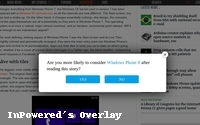 In their own words, Peyman and Pirouz Nilforoush are, “fighting the good fight” in order to help consumers find the
best, most authentic and authoritative content to help them make decisions about brands. And as of today, they want to utilize similar technologies to
help brands understand which content influences consumers’ purchase consideration -- in real-time -- so they can spend more money “amplifying” that content across the Web and social
media circles. But they’re using a funny way to do that. Basically, they’re bringing back the pop-up.
In their own words, Peyman and Pirouz Nilforoush are, “fighting the good fight” in order to help consumers find the
best, most authentic and authoritative content to help them make decisions about brands. And as of today, they want to utilize similar technologies to
help brands understand which content influences consumers’ purchase consideration -- in real-time -- so they can spend more money “amplifying” that content across the Web and social
media circles. But they’re using a funny way to do that. Basically, they’re bringing back the pop-up.
The Nilforoush brothers,
Iranian immigrants who founded and sold tech blogger network NetShelter, and now operate the largely self-serve, real-time native advertising platform InPowered, don’t call their new method a
pop-up. They call it an “overlay,” but basically what happens is that just as a consumer is finishing an article or blog post about some branded product or service, InPowered pops up a
simple question asking them if they are likely to consider the brand the article is about. Based on those responses, the brothers say, advertisers will know which articles to put their ad dollars
behind spreading and promoting.
It’s a simple model, maybe too simple to be used as serious projectable research, but what the method
lacks in statistical probability, they say it gains in real-time responsiveness and decision-making.
Using that method to test two side-by-side
native executions for Honeywell -- one featuring content sponsored by the brand and the other featuring content that was created without beng sponsored by the brand, the organic execution generated
about four-times the purchase consideration (17% for the sponsored content vs. 65% for the organic content).
“Basically, it’s the
first time we’ll be able to measure the impact on purchase consideration for somebody reading an article somebody posts using our platform in real-time,” says Peyman, who describes the
move as part of the brothers mission to match consumers and brands via objective editorial content. We’ll, it’s not 100% objective, because the brands that utilize the InPowered platform
get to filter all of the articles and posts about them based on the sentiment toward their brand -- meaning they pay to spread the ones that are positive about the brand, and they ignore the ones that
are negative. But hey, that’s just the free market at work. The important thing, say the brothers, is that it leverages the free press.
The Nilforoush brothers say they were inspired on this path by growing up in Iran during the 1980s, when objective information wasn’t always easy to come by, and after their parents
emigrated them to Canada they set out to make a business around it. Their first foray was to build the NetShelter network, which they sold earlier this year to Ziff Davis, to focus 100% on the
InPowered platform.
Where NetShelter enabled brands to tap directly into editorial and blogger content about their brands by purchasing
impressions across a network, InPowered leverages technology to scrape content directly from the Web and the blogosphere and put advertising buys behind it to spread it directly to consumers who might
not otherwise have seen it.
The brothers say it is the perfect blend of earned and paid media, because brands earn the coverage organically
from expert journalists and bloggers, and then pay to amplify and distribute it.
“There’s so much conversation about native advertising and
content marketing going on,” explains Peyman, adding, “The think we’re really trying to do is be on the side of the consumer by giving them good content when they are in-market for
it.”